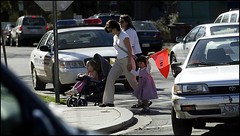Automobile apartheid -- another lesson from Katrina
 Kevin Clark\The Washington Post. Pedestrians make their way across the street with the help of the crossing flags Tuesday afternoon along Connecticut Ave in NW Washington DC. From the article "Battle Flag of the Pedestrians".
Kevin Clark\The Washington Post. Pedestrians make their way across the street with the help of the crossing flags Tuesday afternoon along Connecticut Ave in NW Washington DC. From the article "Battle Flag of the Pedestrians".This essay is relevant to all discussions about transit and even car sharing, and is but one of many reasons why Rosa Parks should be revered.
It's by Joel S. Hirschhorn, author of Sprawl Kills: How Blandburbs Steal Your Time, Health and Money and former Director of Environment, Energy, and Natural Resources at the National Governors Association. He can be reached through SprawlKills.com. From the essay:
Automobile apartheid means anyone who wants mobility through walking, cycling, or public transportation suffers discrimination in a built environment designed for automobiles. In the past 20 years, as automobile addiction has increased, sprawl has run rampant, the number of trips people take by walking has decreased by more than 42 percent, and obesity has skyrocketed.
Personal freedom and independence should mean more than the ability to go wherever one wants, whenever one wants. Americans should also have the freedom to travel how they want. When cars are the only option, freedom is diminished.
Government has largely ignored public safety for second-class citizens. In the past 25 years some 175,000 pedestrians have been killed on America's roadways. Though Americans make less than 5 percent of their trips on foot, 12 percent of all traffic fatalities are pedestrians. Some 60 percent of those deaths occur in places where no crosswalk is available...
While New Orleans' illustration of automobile apartheid stands out, government officials have long enforced it in more subtle ways. The traffic-studies chief of Prince George's County, Maryland once said: "The street should be strictly for cars." New York City's Department of Transportation deactivated 77 percent of the pedestrian walk-push buttons at intersections and left the signs telling pedestrians to use them. For 25 years cars whizzed by hapless pedestrians waiting for a useless walk button to stop traffic.
In early 2003, Georgia's Department of Transportation disclosed it was against having trees between sidewalks and streets because sidewalks are "auto recovery zones." The commissioner said "the protection of intermittent foot traffic should not come at the expense of a motorist's life." Apparently air bags and seat belts are not good enough for first-class citizens.
 Traffic backs up on the Capital Beltway in Fairfax. High-occupancy toll lanes built by private firms have been approved for this stretch of the highway. (By Lucian Perkins -- The Washington Post). From "Md. and Va. to Study Beltway Toll Lanes".
Traffic backs up on the Capital Beltway in Fairfax. High-occupancy toll lanes built by private firms have been approved for this stretch of the highway. (By Lucian Perkins -- The Washington Post). From "Md. and Va. to Study Beltway Toll Lanes".



0 Comments:
Post a Comment
<< Home